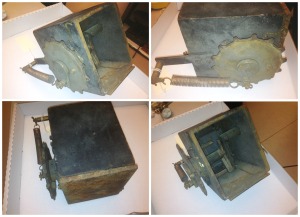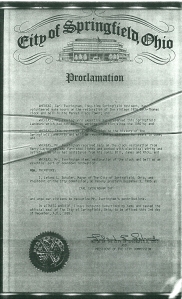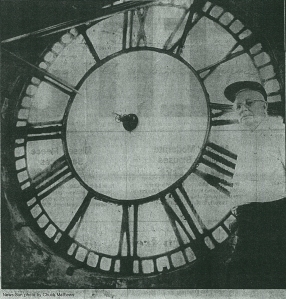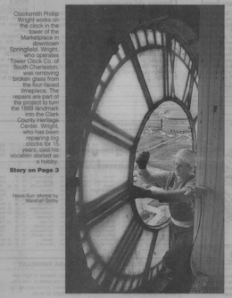On June 25 we shared this image of an artifact in our collections to see if anyone could guess what it was. Our curator Kasey came across this artifact while working on the NEH and History Fund grant funded Collections Management Project in our second floor storage area.
There weren’t a whole lot of guesses….seeder, grinder….thing-a-ma-jig (always a good guess!) and as usual, we revealed the answer the following day.
This was one of four motors that controlled the faces of the clock on our building’s clock tower. The motors were replaced in 1984 when Carl Everingham repaired the clock and got it chiming and working properly for the first time since the 1950s (around the time the two tower steeples were removed). Mr. Everingham offered his expertise to repair the clock free of charge and received help from Harry Laybourne and his sons, Bill, James, and Rick. In honor of his service, December 3, 1985 was declared Carl Everingham day.
More than a decade later, once preparations began for the Clark County Historical Society to move into the building, Phillip Wright of the Tower Clock Company in South Charleston did repairs on the Seth Thomas clock and bell to return it to working condition. (Pictures of the restoration:http://on.fb.me/Vr62MD)
When the City Hall/Marketplace first opened in 1890, the tower was designed to accommodate a clock, but until 1924, there was just a decorative clock-like motif on the tower in place of an actual working clock. At the end of 1924 the clock was installed, a gift to the city from Howard Diehl in memory of his wife. The steeples on the tower were replaced with lighter fiberglass steeples around 2000 before the opening of the Heritage Center.
Twice a year, at least one of our staff members has to make the 166 step trek straight up the narrow tower to change the time on the clock for daylight savings. A couple of years ago our curator, Kasey documented her experience with moving the hands of time! For pictures: http://on.fb.me/Q12zk3





